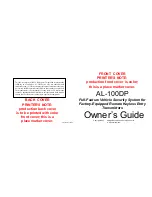
CMS-2 CARBON MONOXIDE MONITOR
Page 6
© 2018 CLEMCO INDUSTRIES CORP.
www.clemcoindustries.com
Manual No. 22925, Rev. I, 04/18
2.4.4.9
When closing the faceplate, make sure all internal
air lines are free of interference, binding, or kinks and that
all tube connections are secure. Tighten the cover screw.
2.4.4.10
Close the instrument case cover and latch it.
2.4.4.11
Attach a positive (+) terminal connector to the
end of the
black
wire and a negative (-) connector to the
end of the
white
wire. Clip the
green
wire.
NOTICE
Use any connectors that are compatible with a
12-volt DC system. Make sure the connectors
are clearly marked positive (+) and negative (-).
Attach the positive connector to the wire
leading to the DC+ post on the circuit board,
and the negative connector to the DC- post on
the circuit board. The monitor will not operate if
wires are reversed.
2.5
Connecting an External Alarm and Shutdown
Device
‒
Figure 4
NOTE: External alarms require external power. Do not
confuse an external alarm with the optional remote alarm,
which does not require external power. Instructions for
the remote alarm are provided with the alarm.
Figure
4
2.5.1
A dry relay contact, rated at 5 amperes, is
mounted on the circuit board as shown in. Figure 4. An
electrician will use the contacts to operate relays for
external alarms and shut-down devices.
2.6
Changing Mode Select Dip Switch to Delay
Alarm
‒
Figure 5
NOTE: In areas where intermittent radio frequency
transmissions cause false alarms, the monitor can
be set to have a 10 second alarm delay to avoid false
alarm conditions. The dip switch is mounted on the
circuit board as shown in Figure 5.
WARNING
Do not change the switch positions unless there
are frequent alarms from radio frequency (RF)
transmissions. Do not change the switch
positions to any position other than noted in
Figure 5. Avoid unnecessary tampering with the
circuit board; doing so can change the monitor’s
settings, which can affect CO alarm conditions.
2.6.1
The default and recommended setting has no
delay in alarm-response time. The positions of the white
mode-select switches are shown on the upper example
in Figure 5 and as follows:
Switch #1 .....Off
Switch #2 ..... On
Switch #3 .....Off
2.6.2
To delay the alarm by 10 seconds, set the white
mode-select switches as shown on the lower example in
Figure 5 and as follows:
Switch #1 .....Off
Switch #2 .....Off
Switch #3 .....Off
Figure
5
Com
NC
NO
Auxiliary Alarm
Typical wiring for normally open alarm
Remote Alarm Plug
Do not connect external
alarms to this plug. This is for
the optional remote alarm
only.
ON
1
2
3
Default Mode, No Delay
Switch #1 Off
Switch #2 On
Switch #3 Off
10 Second Alarm Delay
Switch #1 Off
Switch #2 Off
Switch #3 Off
Dip Switch
ON
1
2
3
Dry Relay Contact
Com
NC
NO
L1
L2
+
External
Power

































